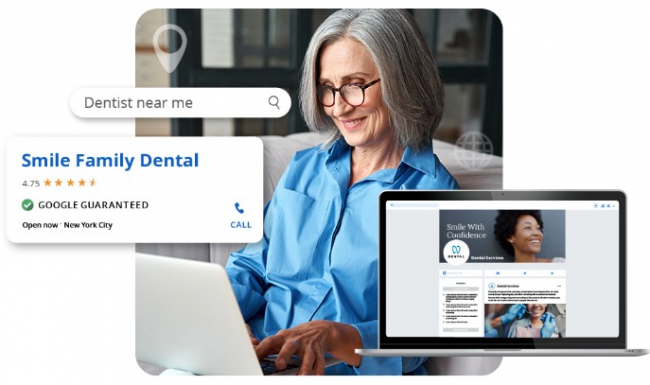
Attracting potential patients who live close to your dental practice is important to patient growth and practice revenue. So, ranking your dental practice website higher in local search results is important to achieve those goals.
How do you do that? What is local SEO? In this complete guide to local SEO, focused on how Google finds and ranks local dental practices, we’ll cover:
And more.

Local SEO (search engine optimization) is a strategy that helps your dental practice website rank higher in local search results. When potential dental patients are searching for a practice, they naturally search for practices that are nearby, and as you may already know, search results on Google can be highly personalized based on geographic location. Someone searching for a local dental practice in New York City, for example, is going to get different results than someone searching for a local dental practice in Los Angeles. Any business that has a physical location in a competitive market can benefit tremendously from a local SEO strategy.

Local search works by searching the web for reviews and ratings of nearby businesses so people can know what’s available to them close to home. Local search also shows people any special services or offers that may be available to them. A local SEO strategy, or local search for dentists, helps dental practices make the most of local searches by getting in front of more potential patients. Through local SEO, dental practices can rank higher in local search results and attract more potential patients in their area through increased visibility. By investing in local SEO, you can ensure your dental practice shows up prominently when potential patients search for the services your dental practice provides. Overall, local SEO is essential to the marketing strategy of any business.
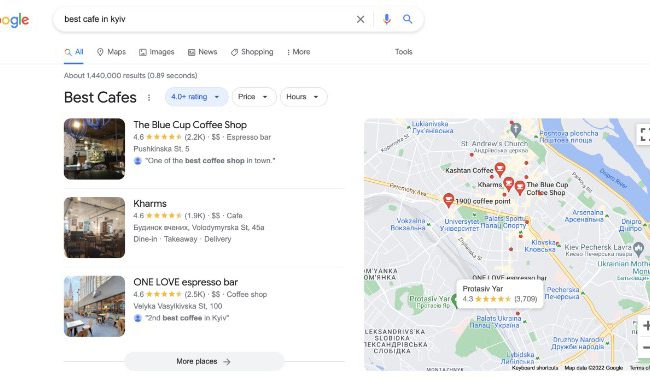
According to Google, results in search engine results pages (SERPs) are primarily based on “relevance, distance, and prominence.” A combination of these factors helps Google find the best match for user queries. For example, Google’s algorithms might decide that your dental practice is more likely to have what a potential patient is looking for, even though your dental practice is farther away from a potential patient than a competing practice.
The Local Pack is a SERP feature that appears on the first page of any search query with local intent. For searches that Google deems local, SERPs display three local businesses. The three-pack shows the top closest and best-ranked businesses that match a search. For dental practices that wish to attract new patients and increase practice revenue, building a local presence and being visible in the local three-pack answers the common practice questions, “Why is local SEO important?” and “What are the benefits of local SEO?”

Local SEO fundamentally works like any Google search. When a potential patient enters a query, Google scans through its index to provide the best results that match a person’s query. The difference with local SEO is that for potential patients looking for a practice in their area, search results display practices that are close in proximity. Local SEO works by optimizing your dental practice website to rank higher in local search results. This means, when potential patients in your area are looking for a new dental practice, you’ll have a better chance of them finding your practice first. To achieve this, local SEO experts use techniques like keyword research, link building (including all-important backlinks), and content optimization to show local searchers that your practice is the one they need. Additionally, local SEO specialists focus on local citations—mentions of your practice across other local websites—which can further improve visibility in local search results.

As explained in our first SEO module, Google keeps the inner workings of its algorithms a closely guarded secret to prevent competitors from copying the algorithms and spammers from using the information to manipulate search results. So, it’s difficult to know which algorithms impact local SEO. Having said this, Google is constantly making updates to its algorithms, and recent updates that have impacted local SEO (as reported by Search Engine Journal) include:
“Despite all of Google’s changes,” writes Search Engine Land, “it seems like the one thing they’ve kept consistent forever has been the reason behind the changes. Google’s goal is to provide consistent, reliable information to consumers searching online.”
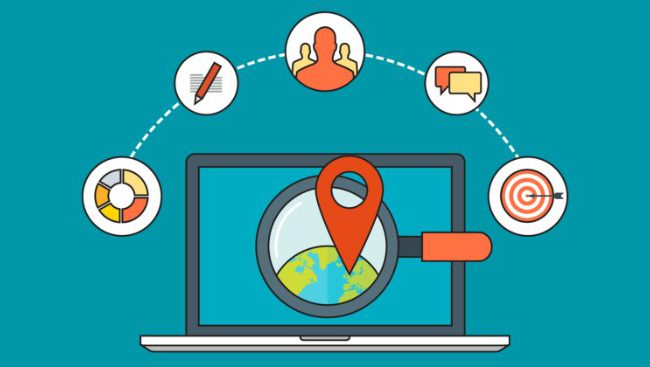
The following elements have been identified as having an impact on local SEO and ranking in local search results:

Google Business Profiles (formerly Google My Business) are those panels of information that commonly come up with photos, links, product/service offerings, and more when you Google a business, and having a Google Business Profile is essential for local SEO. It acts as an online directory. Potential and current patients can find and contact you quickly, and Google can display information about your practice more accurately.
Your Google Business Profile gives people an easy way to learn more about your practice before they take the time to visit in person. To help them with this, a Google Business Profile includes important information such as hours of operation, contact information, and directions—making it easy for potential patients to contact and reach you.
Google reviews are another important aspect of Google Business Profiles and local SEO. Having a Google Business Profile makes it easier for patients to leave their feedback about your practice, providing social proof and instilling trust with potential patients, which encourages them to contact your practice.
A Google Business Profile also gives you insights into how potential patients searched for your dental practice and where those searches came from, which helps optimize your overall dental practice SEO strategy. You can also find information such as how many people called your practice from the number listed on local search results in Google Search and Google Maps. The more information you have about new and potential patients, the better you can tailor your overall practice marketing and communications. From dental social media management to drive people to your practice website to a dental website designed to captivate and convert them once they arrive, the more you know about potential patients, the better you can attract and retain them as patients.
Click here for a quick walkthrough of how to set up and claim ownership of your Google Business Profile.
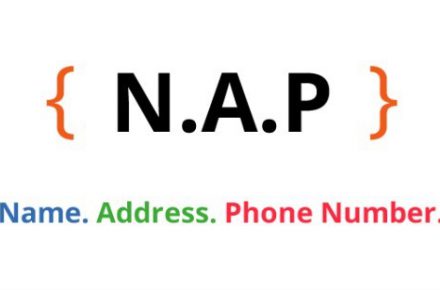
Search engines use your practice’s name, address, and phone number (NAP) to determine appearance and rank in local searches. Having the correct NAP for all your listings across the internet is crucial for local SEO.

As a ranking factor, online reviews are very important to local SEO, and they’re very important in converting potential patients. As shown in SEO module 2[XB2] : According to recent survey findings, 43.3% of people are more apt to choose a dentist with the best online reviews. Moreover, people trust online reviews. According to BrightLocal, 79% of people trust online reviews as much as personal recommendations.

As touched on already, on-page factors affecting local SEO include NAP. Other factors:

Use a keyword research tool like Semrush to analyze which keywords your competitors are ranking for, then plan your keywords accordingly for your local SEO strategy.
Google autocomplete is a feature within Google Search that makes it faster to complete searches that you start to type. SEO professionals and other marketers have used Google autocomplete to understand the questions people are commonly asking and to play their keyword strategy.
Google Keyword Planner is a powerful tool for identifying dental service-based keyword opportunities.
Keyword search volume refers to the number of searches for a particular keyword, which tells you how much traffic a keyword can generate and whether it’s worth your time to use a keyword in your local SEO. Keyword research tools like Google Keyword Planner are useful tools for search volume research.
Local intent is a key part of local SEO. It refers to how likely someone searching online is to visit your dental practice based on what they’ve searched for. For example, if someone searches for “dental practice near me,” it indicates local intent as the user is searching for nearby local practices. To take advantage of local intent in your local SEO strategy, do your website pages reference local neighborhoods? Local landmarks? Are there mentions of nearby towns, cities, provinces, or states? When it comes to local SEO, local intent is just as important as any other aspect of SEO.
Once you’ve completed your keyword research, use your chosen keywords in your website pages to optimize local SEO.
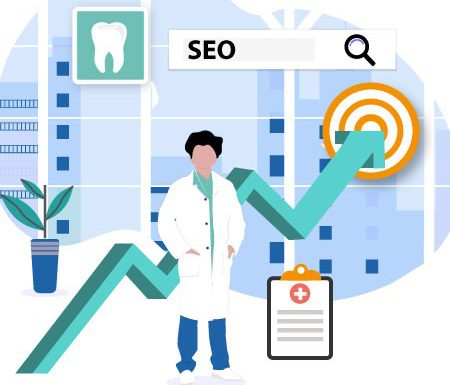
Best dental search engine optimization practices dictate that your benchmark data should also be a window into where you’re doing well, and what areas you can improve on. Whether you’re looking to increase ranking, page visits, time on page, decrease bounce rates, or improve conversions, get clear about your goals to identify how you’ll measure success.
As explained earlier in this module, researching, and identifying dental keywords that people search for is key to local SEO, discovery, and success.
When people visit websites, they expect to find helpful content that’s relevant to why they visited. Google also favors websites that provide high-quality content and penalized websites with content deemed unauthoritative, questionable, or otherwise robotic. So, focus on creating relevant, helpful content, then incorporate keywords into that content.
Localize your page titles and headings with geographic, location-based keywords. Doing this will help potential patients in your area find you quickly while boosting your local SEO score.
Using local SEO keywords in your URLs, title tags, and descriptions is a great way to optimize your practice website for local search results. By including local phrases or words that identify the specific area you serve (such as a city name or zip code) and the specific dental services you offer, you can improve your visibility in local searches.
Internal linking structure plays an important role in local SEO. It’s the backbone of your website, connecting all the different pages and helping search engines better understand what your content is about. Implementing proper internal linking can help boost your local SEO efforts significantly by improving visibility to local customers and increasing dwell time on key web pages. To optimize your local SEO through internal linking, start by creating a basic site map that outlines the main pages of your website and how they relate to each other. This helps search engines better index your content, so it shows up in local search results when people are searching for related terms or services. It also gives you a visual guide to use while setting up links between different pages on your site.
Complete as much information as relevant about your dental practice. Take the time to fill out all details, from hours of operation to contact information and even photos. When potential patients are looking for a local dental practice like yours, having a complete Google Business Profile can be the difference between them giving your practice a call or moving on to one of your competitors.
As previously mentioned, NAP (name, address, and phone number) is important to ranking in local searches. So, make sure your NAP information is consistent for all your listings across the internet.
To strengthen local SEO and convert more potential clients, you’ll need to cultivate more than a few patient reviews. According to Invesp, 50% of people require either 4-6 or 7-10 online reviews before trusting a business. You’ll also need to keep client reviews current as part of your SEO and practice marketing strategy. to BrightLocal:
Here’s more on how to easily collect patient reviews and stay on top of it all.
As a dentist, you understand the importance of making sure your practice can be easily found in local directories. Your goal should be to have an online presence that is comprehensive, accurate, and consistent across all platforms.
Here are some of the best local directories that are particularly useful for dentists.
Remember that searchers and search engines use NAP data to learn who you are and what you do. Look for duplicate or mismatched listings that may appear under an old address, name, or phone number and fix them right away.
Schema markup is code that can be used to create structured information about the content on a web page, which helps search engines understand what the page is about and how it should rank for local searches.
Search engines will prioritize local results when people are searching within a certain area. By creating local pages, you’ll have an advantage over other businesses that don’t have localized content on their websites. Every local page should include information about the area, such as business hours, local attractions, local events, and more. You can also include local contact information so customers can easily get in touch with you.
Create local content to boost local SEO. Local content might include localized blog posts, local events that are relevant to your practice, or interviews with local experts. You can also create videos with local content. Video marketing for dental practices is a powerful way to attract new dental patients.
Google is done with sites that aren’t mobile-friendly. They’ve spelled it out in black and white. So, ensuring website mobile responsiveness is essential for SEO success.
Building a strong local link profile is critical to local search engine rankings. To get the best local link results, you must go beyond just getting any old links. You need to make sure they come from local, relevant sources.
Authoritative inbound links (Step 16) include press coverage with relevant local media outlets.
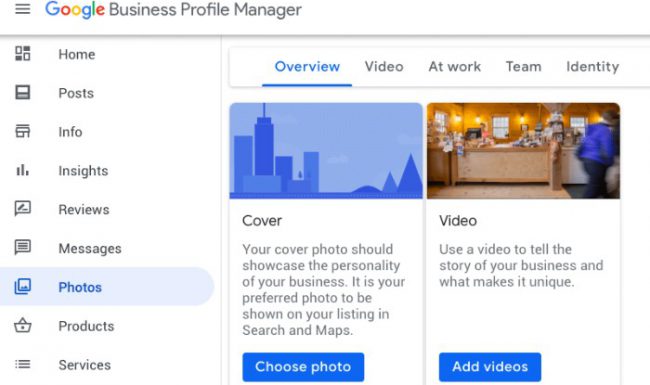
As part of Google Business Profile, Google Business Manager is a profile for your dental practice. You or a staff member can create this profile directly. In many cases, Google Business Manager is one stop for handling the look and success of your dental practices in search engine results.
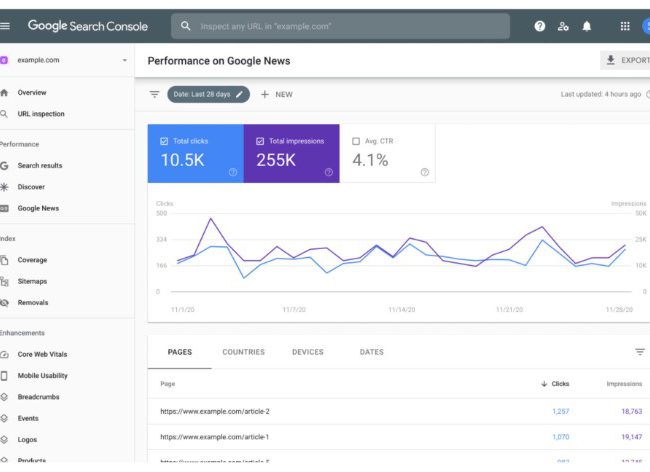
Google Search Console is a set of tools created by Google to help website owners understand how it crawls their content and provides insights into optimizing their site for better visibility in organic search engine results. With features such as an index status checker, keyword rankings tracking, URL inspection tool, internal link analysis, structured data testing and more, Google Search Console can provide you with crucial information about how well your site is performing on the web.
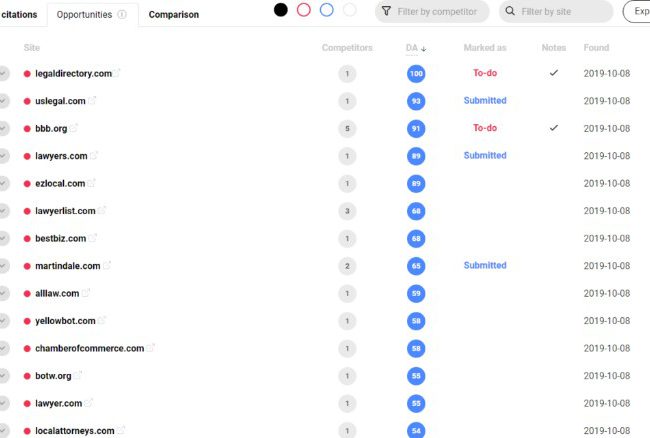
A local citation finder is an invaluable tool for local SEO. It helps you identify which local directories your business should be listed on and where existing listings may need to be updated.
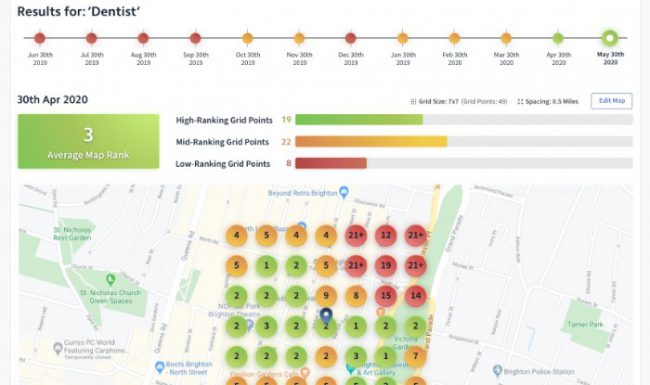
A local search grid is an important factor in local SEO. It helps local businesses increase their visibility online and make sure that they appear in local searches. The local search grid is based on a set of specific geographical locations, such as cities or zip codes, which are then targeted by search engines to serve localized results for local searches.
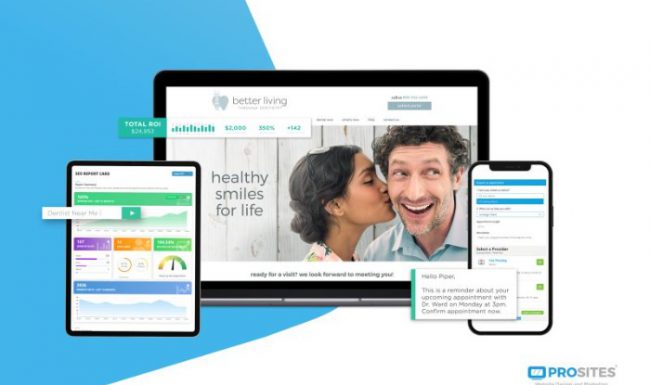
Q: How does Google find and rank local dental practices?
A: When local people want to find local dental practices, Google is their go-to source. However, a local business can’t just appear on the top of the search engine results pages. It takes local SEO work. Local SEO helps make sure that local businesses have the right information included in their online profiles and content, so they show up when someone searches for local services like dental checkups or teeth whitening. This includes ensuring there are consistent NAP listings across the web and optimizing website content with local keywords.
Q: How does Google find and rank local dental practices?
A: When local customers search for dental practices near them, Google looks at local SEO factors to determine which local businesses should appear in their search results. Local SEO involves optimizing content and signals both on-page and off-page that specifically relate to local web searches. This includes claiming your business profile on local directories.
Q: What information do businesses need to provide for local SEO?
A: To ensure your local business shows up in local search results, you’ll want to provide certain information that local search engines look for when ranking local content. The most important pieces of information to include are your business name, address, and phone number.
Q: What citation sites are important for local SEO?
A: When it comes to local SEO, citations are very important. Citations are references to your business on other websites, and they help local search engines find you more easily. Some of the most important citation sites include Google My Business, Yelp, Yellow Pages, MapQuest, Superpages, Foursquare and Apple Maps.
Q: How does mobile search affect local SEO?
A: With many people now relying on mobile devices for local search, it is increasingly important to make sure your dental practice shows up in local searches. Mobile search affects local SEO in several ways. First, mobile users are more likely to use location-based keywords when searching on their devices. This means local businesses need to optimize their local SEO strategy to include local-specific keywords, such as the name of the city or region where they are located. Second, local searches take a user’s physical location into account.
Q: Why does local search matter?
A: Local SEO matters because local patients are likely to search for local dental practices when they need something. If your practice doesn’t appear in local searches, local patients won’t even know your practice exists. So, they won’t be able to benefit from the services that your practice offers. Search engine optimization helps practices get more local visibility on search engines like Google and Bing so that local patients can find them easily. With local SEO, you can get ahead of the competition by ensuring that your practice shows up first in relevant local searches.
Q: How do you know if you need local SEO?
A: If your dental practice isn’t ranking well in local search results if your practice wants to attract more patients and fill more chairs, or if your practice wants to increase revenue, your practice likely needs a local SEO strategy.
The challenge facing many (if not most) practices in the achievement of local SEO goals is time. There never seems to be enough of it, which is why more dental practices are using online marketing providers like ProSites.
Trusted by dental practices everywhere and endorsed by 15 dental organizations, ProSites helps practices thrive with a comprehensive suite of website design, SEO, and internet marketing services to help dental practices attract, engage, and connect with more patients. By taking advantage of ProSites’ comprehensive suite of services, dental practices can increase their visibility in local areas, attract more patients, and achieve measurable results.